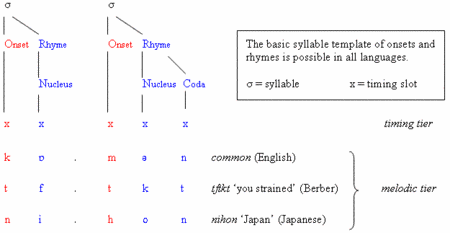Syllable: Difference between revisions
imported>John Stephenson (Started as an internal article) |
imported>John Stephenson (Added Syllable.gif with description) |
||
| Line 1: | Line 1: | ||
The '''syllable''' is a unit of organisation in [[phonology]], the system responsible for the patterns of sounds and signs in [[language]]. Typically, a syllable consists of a [[vowel]] and at least one [[consonant]], though various combinations are possible, including single vowels. The number and type of syllables in a word, phrase or sentence may strongly influence [[stress (linguistics)|stress]] and [[intonation]] throughout. | The '''syllable''' is a unit of organisation in [[phonology]], the system responsible for the patterns of sounds and signs in [[language]]. Typically, a syllable consists of a [[vowel]] and at least one [[consonant]], though various combinations are possible, including single vowels. The number and type of syllables in a word, phrase or sentence may strongly influence [[stress (linguistics)|stress]] and [[intonation]] throughout. | ||
[[Image:Syllable.gif|450px|right|thumb|Onset-Nucleus-Coda: one view of the structure of the syllable, showing the syllabification of three words in English, [[Japanese language|Japanese]] and [[Berber languages|Berber]].]] | |||
In [[linguistics]], the existence of syllables as organisers of [[speech]] sounds and [[sign language]] movements is typically used to explain observations about what is possible in language, from [[native speaker]]s’ perceptions of how many 'beats' there are in a word to the possible ordering of segments such as ''c'', ''a'' and ''t'' in ''cat'': why [[English language|English]] speakers 'feel' there are two syllables in ''mother'' but only one in ''fire'', and why *''nxalr'' is not a possible word in English and, indeed, most languages. | In [[linguistics]], the existence of syllables as organisers of [[speech]] sounds and [[sign language]] movements is typically used to explain observations about what is possible in language, from [[native speaker]]s’ perceptions of how many 'beats' there are in a word to the possible ordering of segments such as ''c'', ''a'' and ''t'' in ''cat'': why [[English language|English]] speakers 'feel' there are two syllables in ''mother'' but only one in ''fire'', and why *''nxalr'' is not a possible word in English and, indeed, most languages. | ||
Revision as of 21:27, 3 April 2007
The syllable is a unit of organisation in phonology, the system responsible for the patterns of sounds and signs in language. Typically, a syllable consists of a vowel and at least one consonant, though various combinations are possible, including single vowels. The number and type of syllables in a word, phrase or sentence may strongly influence stress and intonation throughout.
In linguistics, the existence of syllables as organisers of speech sounds and sign language movements is typically used to explain observations about what is possible in language, from native speakers’ perceptions of how many 'beats' there are in a word to the possible ordering of segments such as c, a and t in cat: why English speakers 'feel' there are two syllables in mother but only one in fire, and why *nxalr is not a possible word in English and, indeed, most languages.
The existence of the syllable as an abstract phonological unit that limits the possible sequences of segments is not uncontroversial, and its use in mainstream linguistics literature has been inconsistent. Theories predating the arrival of the currently-mainstream generative phonology, as well as more recent approaches from within generativism itself, have called into question or even outright rejected the syllable in favour of other behavioural explanations from within both phonology and phonetics.
